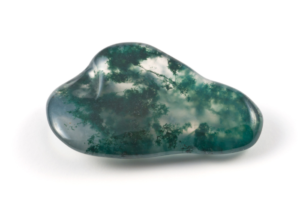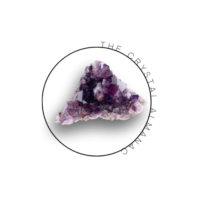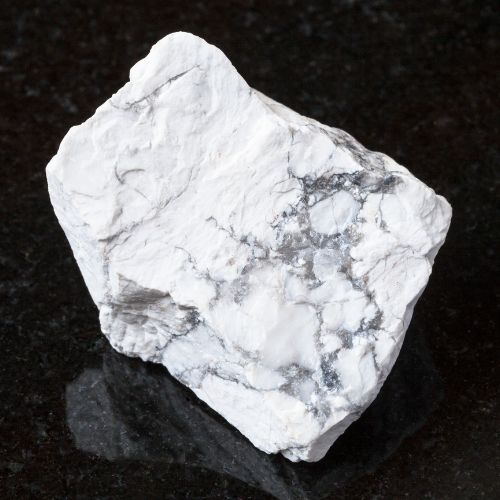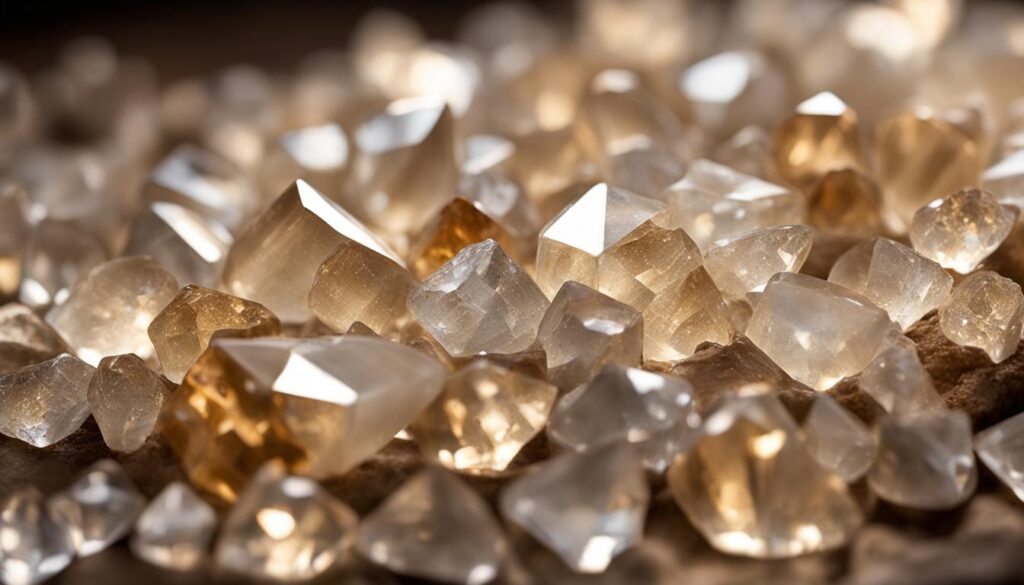Moss Agate, also known as the “Stone of Mother Gaia,” is a variety of chalcedony included in the Agate family. It is a semi-precious stone made from silicon dioxide. Moss Agate is celebrated as a lucky amulet, with its green hues evoking feelings of being close to nature and its ability to uplift and soothe. It offers physical healing by boosting the immune system, providing anti-inflammatory properties, and promoting a healthy digestive system. Emotionally, it balances moods, enhances self-esteem, and fosters emotional stability. This stone is deeply connected to the heart chakra and ensures unobstructed love and abundance flow, nurturing friendships and bringing peace to existing relationships. Moss Agate can be placed in homes or offices to attract abundance and prosperity and can be worn as jewelry to imbue the wearer with its healing vibes. It is especially beneficial when paired with other healing stones like Amethyst, Blue Lace Agate, and Tigers Eye. To cleanse and recharge Moss Agate, it can be smudged with lavender or sage, run under water, or placed near plants or greenery to harness the energy of nature.
Key Takeaways:
- Moss Agate is a variety of chalcedony known as the “Stone of Mother Gaia.”
- It offers physical healing by boosting the immune system and providing anti-inflammatory properties.
- Emotionally, Moss Agate balances moods, enhances self-esteem, and fosters emotional stability.
- It is deeply connected to the heart chakra, nurturing love and abundance in relationships.
- Moss Agate can be used in homes and offices to attract abundance and prosperity.

The Gemstone of Mother Gaia
Moss Agate, often referred to as the “Stone of Mother Gaia,” captures the natural vibes of being close to nature. Its green colors and swirling patterns resemble moss or vegetation, evoking a sense of tranquility and connection to the Earth. This gemstone is found in various locations around the world, including the USA, Brazil, India, Uruguay, South Africa, Australia, and Russia. It has been used for centuries as a lucky amulet, attracting prosperity and abundance. Moss Agate is believed to enhance the beauty and vitality of flowers, boost business success when placed in the workplace, and bring a sense of peace and harmony when carried with you. Its mystical properties make it a powerful stone for healing and rejuvenation.
Moss Agate is a variety of chalcedony, belonging to the quartz family. It is composed of silicon dioxide and has a hardness of 6.5 to 7 on the Mohs scale. The intricate patterns and colors of Moss Agate are created by the presence of oxides of manganese or iron, which form the moss-like inclusions. The colors can vary depending on the minerals or metals present, such as green, blue, red, yellow, and brown. Moss Agate is primarily found in India, Brazil, Uruguay, central Europe, and the western United States. It is often found as fragments from weathered volcanic rock or as pebbles.
The Spiritual Connection
Moss Agate’s connection to nature and its lush green hues make it a favored stone for spiritual practices. It is believed to help establish a deep connection with Mother Earth and can aid in grounding and centering during meditation. The stone’s calming energy can bring a sense of peace and tranquility, allowing for spiritual growth and self-reflection. Moss Agate is also associated with the heart chakra, promoting love, compassion, and emotional healing. It is often used in crystal grids and energy healing practices to enhance the flow of positive energy and manifest intentions.
Green Agate: A Symbol of Growth and Renewal
Green Agate, another name for Moss Agate, symbolizes growth and renewal. Its vibrant green color represents the vitality and abundance found in nature. Green Agate is often used to attract new opportunities, prosperity, and success. It is believed to inspire personal and professional growth, fostering creativity, and boosting self-confidence. This gemstone can be worn or carried with you as a reminder to embrace change, embrace new beginnings, and to embrace the beauty of life’s journey.
Moss Agate Healing Properties
Moss Agate offers a range of healing properties that benefit the mind, body, and spirit. Its physical healing abilities include boosting the immune system, reducing inflammation, and promoting a healthy digestive system. This stone is also known for its emotional healing properties, as it helps balance moods, enhance self-esteem, and foster emotional stability.
When it comes to metaphysical properties, Moss Agate is deeply connected to the heart chakra. It ensures a free flow of love and abundance, nurturing friendships and bringing peace to existing relationships. In addition to its emotional and metaphysical benefits, Moss Agate is associated with the zodiac sign Virgo and is believed to attract prosperity, success, and new beginnings.
Physical Healing Properties
- Boosts the immune system
- Provides anti-inflammatory properties
- Promotes a healthy digestive system
Emotional Healing Properties
- Helps balance moods
- Enhances self-esteem
- Fosters emotional stability
Metaphysical Properties
- Connected to the heart chakra for love and abundance
- Attracts prosperity, success, and new beginnings
Moss Agate can be used for spiritual growth and finding inner peace. It is a versatile stone that can be incorporated into various aspects of life, offering its healing energies to those who seek it.
Using Moss Agate
Moss Agate, with its powerful healing properties and connection to nature, can be incorporated into various aspects of your life. Here are some ways to use Moss Agate:
1. Home Décor:
Place Moss Agate in specific areas of your home to attract abundance and prosperity. According to Feng Shui principles, displaying Moss Agate in the southeast and eastern areas can enhance its positive energies.
2. Jewelry:
Wearing Moss Agate jewelry allows for direct contact with the stone, maximizing its healing benefits. Bracelets, necklaces, and rings made from Moss Agate can continuously radiate its balancing energies throughout the day.
3. Meditation & Healing Practices:
Hold Moss Agate during meditation or healing practices to connect with its soothing and rejuvenating energies. Keep it nearby to promote emotional stability, tranquility, and spiritual growth.
Remember to regularly cleanse and recharge your Moss Agate crystal to maintain its positive energy. Explore different methods such as smudging with lavender or sage, running it under water, or placing it near plants or greenery to harness the energy of nature. By incorporating Moss Agate into your daily life, you can experience its transformative effects on your well-being and overall energy.
How to Cleanse Your Moss Agate Crystal
If you own a Moss Agate crystal and want to ensure its positive energy remains vibrant, it’s important to cleanse and recharge it regularly. Here are some methods you can use to cleanse your Moss Agate:
1. Smudging:
Smudging your Moss Agate crystal with lavender or sage is a popular and effective way to purify its energy. Simply pass the crystal through the smoke of the smudging tool while setting your intention to cleanse away any negative energies.
2. Water Cleansing:
Another method is running your Moss Agate crystal under water. However, please be cautious not to immerse it for too long, as prolonged exposure to water may damage the stone. Ensure that you dry the crystal completely before using or storing it afterward.
3. Nature’s Energy:
Moss Agate has a strong connection to nature, so placing it near plants or greenery can help recharge its energy. The vibrant life force of plants will infuse your crystal with fresh and revitalizing energy.
Remember, cleansing your Moss Agate crystal is essential to maintain its positive vibrations and ensure its effectiveness in healing and balancing. Find the method that resonates with you and make it a part of your regular crystal care routine.
Geological Properties of Moss Agate
Moss Agate, a variety of chalcedony, belongs to the quartz family and is composed of silicon dioxide. With a hardness of 6.5 to 7 on the Mohs scale, this stone is durable and resistant to scratching. The remarkable patterns and colors of Moss Agate are formed by the presence of oxides of manganese or iron, creating beautiful moss-like inclusions within the stone.
The colors in Moss Agate can vary depending on the minerals or metals present, offering a range of hues such as green, blue, red, yellow, and brown. This mesmerizing gemstone is primarily found in India, Brazil, Uruguay, central Europe, and the western United States. It is often discovered as fragments from weathered volcanic rock or as smooth pebbles, adding to its unique appeal.
Understanding the geological properties of Moss Agate allows us to appreciate its natural beauty and the intricate processes that form this captivating stone. Its composition and formation contribute to its energetic properties, making it a cherished crystal for healing, balance, and connection to nature.
FAQ
What is the meaning of Moss Agate?
Moss Agate is celebrated as a lucky amulet, with its green hues evoking feelings of being close to nature and its ability to uplift and soothe.
What are the healing properties of Moss Agate?
Moss Agate offers physical healing by boosting the immune system, providing anti-inflammatory properties, and promoting a healthy digestive system. Emotionally, it balances moods, enhances self-esteem, and fosters emotional stability.
How can Moss Agate be used in daily life?
Moss Agate can be placed in homes or offices to attract abundance and prosperity and can be worn as jewelry to imbue the wearer with its healing vibes. It is especially beneficial when paired with other healing stones like Amethyst, Blue Lace Agate, and Tigers Eye.
How can I cleanse and recharge my Moss Agate crystal?
To cleanse and recharge Moss Agate, it can be smudged with lavender or sage, run under water, or placed near plants or greenery to harness the energy of nature.
What are the geological properties of Moss Agate?
Moss Agate is a variety of chalcedony composed of silicon dioxide. The intricate patterns and colors are created by the presence of oxides of manganese or iron. It has a hardness of 6.5 to 7 on the Mohs scale.


